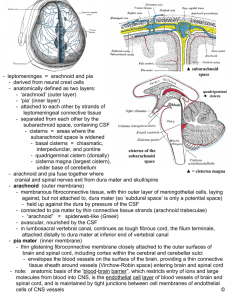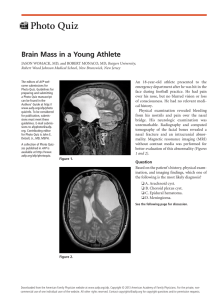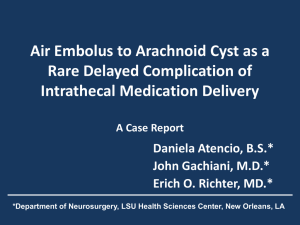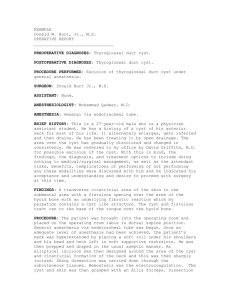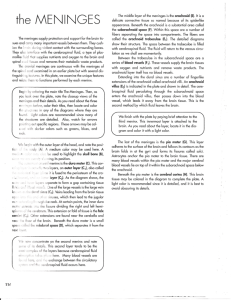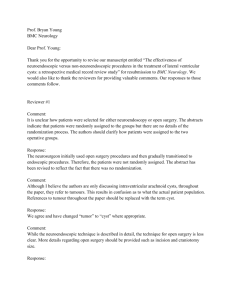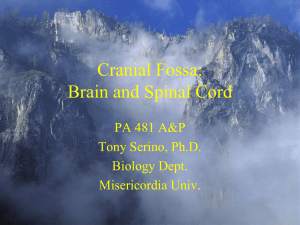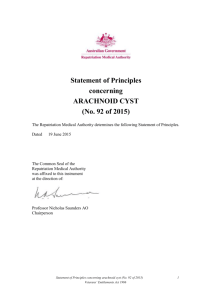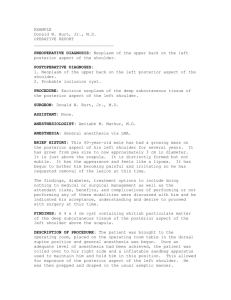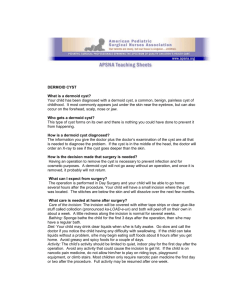PREOPERATIVE DIAGNOSIS: Progressively enlarging left
advertisement
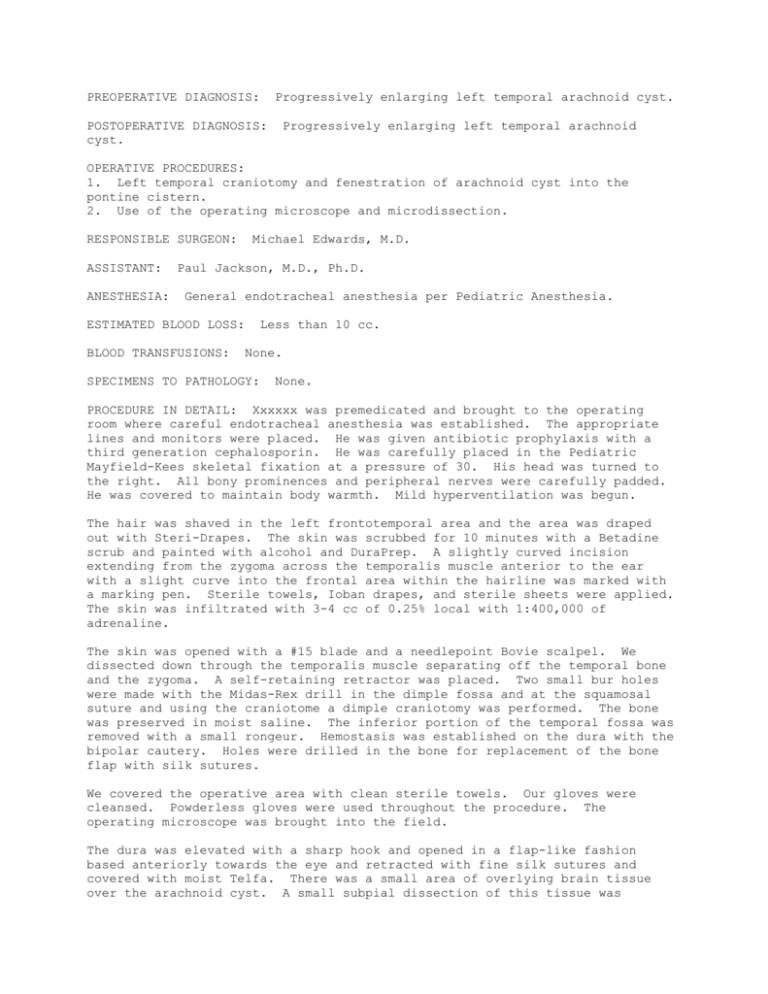
PREOPERATIVE DIAGNOSIS: Progressively enlarging left temporal arachnoid cyst. POSTOPERATIVE DIAGNOSIS: cyst. Progressively enlarging left temporal arachnoid OPERATIVE PROCEDURES: 1. Left temporal craniotomy and fenestration of arachnoid cyst into the pontine cistern. 2. Use of the operating microscope and microdissection. RESPONSIBLE SURGEON: ASSISTANT: ANESTHESIA: Michael Edwards, M.D. Paul Jackson, M.D., Ph.D. General endotracheal anesthesia per Pediatric Anesthesia. ESTIMATED BLOOD LOSS: BLOOD TRANSFUSIONS: Less than 10 cc. None. SPECIMENS TO PATHOLOGY: None. PROCEDURE IN DETAIL: Xxxxxx was premedicated and brought to the operating room where careful endotracheal anesthesia was established. The appropriate lines and monitors were placed. He was given antibiotic prophylaxis with a third generation cephalosporin. He was carefully placed in the Pediatric Mayfield-Kees skeletal fixation at a pressure of 30. His head was turned to the right. All bony prominences and peripheral nerves were carefully padded. He was covered to maintain body warmth. Mild hyperventilation was begun. The hair was shaved in the left frontotemporal area and the area was draped out with Steri-Drapes. The skin was scrubbed for 10 minutes with a Betadine scrub and painted with alcohol and DuraPrep. A slightly curved incision extending from the zygoma across the temporalis muscle anterior to the ear with a slight curve into the frontal area within the hairline was marked with a marking pen. Sterile towels, Ioban drapes, and sterile sheets were applied. The skin was infiltrated with 3-4 cc of 0.25% local with 1:400,000 of adrenaline. The skin was opened with a #15 blade and a needlepoint Bovie scalpel. We dissected down through the temporalis muscle separating off the temporal bone and the zygoma. A self-retaining retractor was placed. Two small bur holes were made with the Midas-Rex drill in the dimple fossa and at the squamosal suture and using the craniotome a dimple craniotomy was performed. The bone was preserved in moist saline. The inferior portion of the temporal fossa was removed with a small rongeur. Hemostasis was established on the dura with the bipolar cautery. Holes were drilled in the bone for replacement of the bone flap with silk sutures. We covered the operative area with clean sterile towels. Our gloves were cleansed. Powderless gloves were used throughout the procedure. The operating microscope was brought into the field. The dura was elevated with a sharp hook and opened in a flap-like fashion based anteriorly towards the eye and retracted with fine silk sutures and covered with moist Telfa. There was a small area of overlying brain tissue over the arachnoid cyst. A small subpial dissection of this tissue was carried out. The Greenberg retractor was attached to the head holder. The brain tissue was covered with moist Adaptic and lightly retracted with the Greenberg retractor exposing the outer layer of the arachnoid cyst which was moderately vascular. The blood vessels of the arachnoid cyst were coagulated and under higher magnification, the outer wall of the arachnoid cyst was excised with microscissors and small forceps. This led us directly into the temporal fossa and the arachnoid cyst. There were two large veins running in the arachnoid cyst which were coagulated to prevent the possibility of either early or delayed bleeding. By repositioning the retractor superiorly, we were able to identify the free margin of the tentorium and the arachnoid overlying the optic nerve, the carotid artery, and then posterior to the carotid artery the interval between the carotid artery and brainstem. Using the microdissector and microscissors, we opened the arachnoid paralleling the third nerve and the tentorium. This was opened widely beneath the third nerve and above the third nerve exposing the membrane of Liliequist. Using a #11 blade, the membrane of Liliequist was incised and widely opened visualizing the prepontine cistern, the basilar artery, and the fourth and sixth cranial nerves which could be visualized below this under high power. A wide fenestration of the arachnoid, which was the medial portion of the arachnoid cyst, was made allowing CSF to empty from the arachnoid cyst into the prepontine cistern. The operative site was copiously irrigated with saline. The retractor was removed. A small piece of Surgicel was placed over the brain surface. The brain was very relaxed. We again irrigated with Physiosol and filled the cavity with warm Physiosol. The dura was reapproximated with interrupted 5-0 dural sutures and a small artificial EnDura graft. A watertight closure was carried out. We irrigated the operative area with saline and bacitracin solution. FloSeal was placed in the epidural space and then 4-0 Nurolon dural tacking sutures. Sutures of 2-0 silk had been placed through the holes in the skull and corresponding holes in the bone flap and the bone flap was reattached with silk sutures. We irrigated again with antibiotic solution. I failed to mention that a piece of DuraGen was placed over the suture line to prevent CSF leakage. The retractors were removed. The muscle was irrigated. The muscle was closed by alternating muscle and fascia using interrupted 3-0 Vicryl suture. The subcutaneous tissue and galea were closed with inverted interrupted 4-0 Vicryl. The skin was closed with running 5-0 Monocryl. Xeroform gauze, Telfa, and Tegaderm dressings were applied. The child was taken out of the head holder. He was awoken, extubated, and returned to pediatric intensive care unit in stable condition. Xxxxxx tolerated the procedure well and there were no intraoperative complications. Needle, sponge, and cottonoid count was correct. NOTE: I was the primary surgeon present throughout the procedure, with the assistance of Dr. Paul Jackson.
